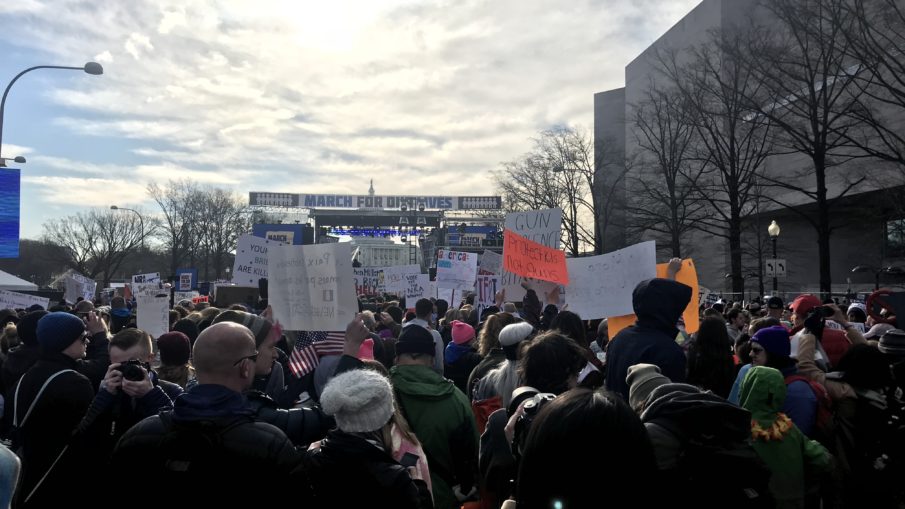The day after the now infamous Marjorie Stoneman High School shooting, I still had no idea if this tragedy was going to be any different than the countless others in my lifetime. I assumed that we would hear all about the troubled life of the perpetrator, briefly argue gun control policies, and inevitably, forget about it the next week. But, on February 15th, one of my long-time best friends, Ellie, retweeted a video recorded by a student involved in the attack. I watched the footage more times than I could count, and the video’s images stayed with me – students hushed each other through sobs and stared at the bloodied body of their classmate before running through the halls riddled with gore. When I saw a girl hardly younger than me lying on the floor, I couldn’t help but mentally replace her body with Ellie’s. Every time I saw her, dead on the tile of her school, I thought “That could be my friend. She’s no different from this girl – it could just as easily be her.” I immediately texted the friend I was thinking of.
“Don’t you dare die in a school shooting,” I said, “If that ever happened, I don’t know what I’d do. I love you.”
I spent the whole next day worried about my friends who are still in high school. What if it happened here? What would happen if someone went to their school? Would they know what to do? What if they were harmed? Even killed?
I tried to tell myself to trust the school system. It’s all I can do, I thought, just hope that schools have a plan for students in that situation. It worked for a while, but then I realized I was probably lying to myself. While most schools are required to have some kind of procedure in place, from my own experience with these procedures, I know that it’s unlikely that students are truly prepared for active shooter situations.
I’ve seen the mandatory security video a few times in my years at FCC, but not in every class. In fact, this semester only one of my professors showed it, and truthfully, I’m not sure how much practical help the video has to offer. The video depends on the ability of students to barricade doors, flee classrooms, and ultimately, defend themselves. While all of these are good strategies to have in general, at FCC there are multiple disabled professors as well as students, and many classrooms are extremely vulnerable to attack. Some have walls entirely made up of windows. Others are open space with nowhere for students to hide.
By looking at other colleges, though, it’s clear that there are better ways to prepare. Bates College of Lewiston, Maine, for example, has an entire page on its website outlining the procedures in case of an active shooter emergency. The college provides survival strategies, as well as safety practices such as, “keep your hands raised and keep them visible at all times,” and “avoid making sudden moves or grabbing the police officers.” By titling the page “Active Shooter Protocol,” Bates acknowledges the danger at hand and proceeds to equip their students with the tools needed to survive that kind of situation. California State University also has a video that it has used to equip students. The eight-minute video uses an honest voice about the possibility of an active shooter. Instead of using vague language about a “lockdown emergency,” CSU uses terms like “active shooter.” The university takes a realistic perspective on what a mass-shooting would actually be like, and what students would need to know.
FCC’s “Campus Security and Safety” video uses general, somewhat-helpful strategies to defend against the threat of a shooter, but without the same kind of honest and specific instruction given at other schools, I don’t believe that our students are prepared. Even if the video were adequate, few professors even show the video at the beginning of the semester as they’re required to do. They claim that students have already seen it a thousand times, and it’s not worth class time to repeat it. If the video is shown, professors do not explain or seem to have classroom specific survival strategies. There is an active shooter preparedness video at the bottom of FCC’s security page, but it is far less detailed than other school’s security measures and most students have not seen it. This semester, one of my professors took it upon herself to create detailed plans outlining who is to do what in case of emergency, but my professors should not be given the task of keeping students safe. The college, as well as our government, should be protecting students from mass-shootings. There should be laws in place and wholly functional protocols to keep students alive at school.
Parkland survivors took their plea to protect schools and built a movement, which took form at March for Our Lives in D.C. Students across the nation gathered to use their voices and be heard by our government. For some, it was a chance to play a part in our democracy, despite being too young to vote. For others, it was an opportunity to stand for what they believe in. But, for all in attendance, it was a time to heal. We collectively mourned those lost to gun violence, carried each other’s grief, and shared in our unified fear of being “next.” Gun violence was spoken about openly – no sugar coating, no political buzzwords. The event was not for the left or against the right. It was simply students asking to be kept safe at school.
I hope that someday in my lifetime, there won’t be a need for rallies like this one. I hope that my children will never need to be a part of a lockdown drill; that one day no one will be afraid at school. I hope that day comes quickly. However, that day is not here yet, and I don’t believe that it will come until our government enacts policies that work toward that goal. Until then, we have to train ourselves and arm our students and faculty with practical strategies for these scenarios.


LOVE THIS, A! Keep it up, you star ((: